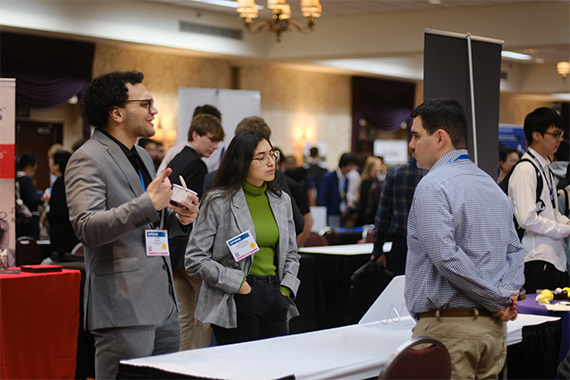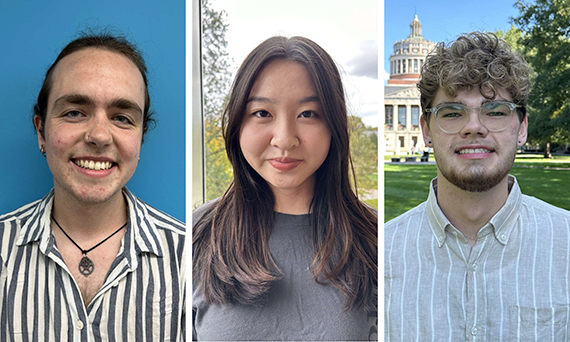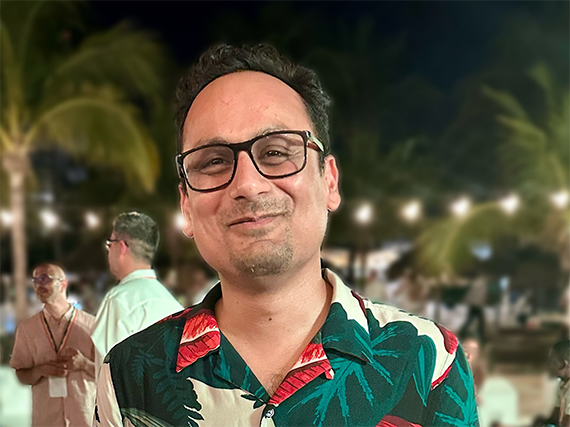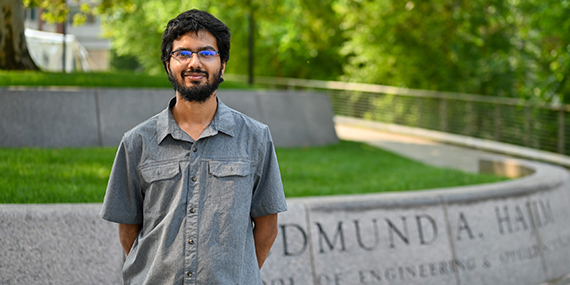October 23, 2023

Optics PhD students Yossif Elmadny, left, and Valeria Viteri-Pflucker, center, meet with optics industry representatives during the company connection showcase at the fall 2023 meeting of the Industrial Associates of the Institute of Optics. (Photo credit: Jinhong “Mint” Lu)
Last week, the University welcomed industry professionals from around the globe for the fall 2023 meeting of the Industrial Associates of the Institute of Optics. For nearly 50 years, this program has been an important venue for our students and faculty to connect with optics and photonics industry partners, launching countless successful careers and scientific discoveries.
For the first time in the program’s history, the Industrial Associates program has 60 member companies, an incredible testament to how much value this program brings in connecting industry and academic research. This year, we were delighted to include not only students and faculty from the University of Rochester to present their research, but also more than 70 people from Rochester Institute of Technology, showcasing the broader scope of our region’s expertise in optics and photonics.
With more than 300 students currently enrolled at the Institute of Optics, this program is an invaluable opportunity for them to showcase their research skills in front of the world’s leading optics manufacturers, developers, and researchers. The networking opportunities it provided surely helped our students secure some exciting new internships and first jobs out of school.
I want to thank Institute of Optics Director Tom Brown for his leadership and the incredible team behind the scenes who made the program happen. They include Tal Haring, Kai Davies, Dustin Newman, Ed Herger, Meir Brea, Lynn Reiner, Adrienne Snopkowski, Lori Russell, and Mike Pomerantz.
WELLS PRIZE WINNERS STAND OUT FOR WORK IN ENGINEERING AND THE HUMANITIES

(l to r) Adam Cummings, Qiyuan “Yvonna” Feng, Riley Prewett are the recipients of the 2023 Wells Prize. (Photos provided)
I am thrilled to announce the three outstanding and well-rounded undergraduate students who received this year’s Robert L. Wells Prize. The Wells Prize is awarded annually by the Hajim School to high-achieving seniors who excel in both an engineering or computer science discipline as well as a humanities field.
This year’s Wells Prize winners are:
Adam, Yvonna, and Riley have excelled both in and out of the classroom. They have taken advantage of so many of the experiential learning opportunities that make our Hajim students stand out—from study abroad trips to internships to volunteer work. Read more about each Wells Prize winner at the News Center.
EHSAN HOQUE EARNS 10-YEAR IMPACT AWARD

Ehsan Hoque received a 10-year-impact award by the Association for Computing Machinery’s (ACM) pervasive and ubiquitous computing (UbiComp) community. (Photo provided)
Congratulations to Associate Professor Ehsan Hoque from the Department of Computer Science, who received tremendous recognition for his pioneering work and long-term effect on the field of human-computer interaction. Ehsan is the first author on a paper that received a 10-year-impact award by the Association for Computing Machinery’s (ACM) pervasive and ubiquitous computing (UbiComp) community.
“This paper explored the potential of vision-based conversational interfaces in enhancing human skills—from acing job interviews and mastering public speaking to assisting individuals with autism,” says Ehsan. “This concept inspired the ‘presenter coach’ feature in Microsoft PowerPoint, now utilized daily by millions.”
The paper details the MACH (My Automated Conversation coacH) system, an animated character that can see, hear, and respond in real time while people practice social interactions in private. Created for Ehsan’s PhD thesis at MIT, the system yielded the first scientific evidence that it is possible for humans to improve their face-to-face interpersonal skills through a virtual assistant.
The paper caught immediate attention at the time it was published, winning a best paper award at UbiComp 2013. The project was highlighted by the MIT Museum as one of the most unconventional inventions at MIT.
Ehsan accepted the award at the UbiComp conference in Cancún, Mexico. Please join me in congratulating him for this wonderful accomplishment.
COMPUTER SCIENCE STUDENT EARNS GOOGLE PHD FELLOWSHIP

Md. Saiful Islam received a prestigious Google PhD Fellowship in health. (Photo provided)
Congratulations to Md. Saiful Islam, a computer science PhD student who received a prestigious Google PhD Fellowship in health. The fellowship was created to recognize outstanding graduate students doing exceptional and innovative research in areas relevant to computer science and related fields. Fellowships support promising PhD candidates of all backgrounds who seek to influence the future of technology.
Saiful’s research focuses on multimodal machine learning and its applications to healthcare. In particular, he is working on enabling neurological care available anytime, anywhere, using computer vision. He is working in collaboration with the neurology department of the University of Rochester Medical Center. His clinical collaborators include Associate Professor Jamie Adams; Ray Dorsey, the David M. Levy Professor of Neurology; and Associate Professor Ruth Schneider. His PhD advisor is Ehsan Hoque.
Saiful also led a recent study outlining an online AI-based test for Parkinson’s disease severity. Please give him a hearty congratulations!
QUASIPARTICLES COULD POWER NEW SUPER-BRIGHT LIGHT SOURCES

A team of scientists ran advanced computer simulations on supercomputers to propose a way to use quasiparticles for super-bright light sources. (Image credit: Bernardo Malaca)
One of our scientists is part of a team rethinking the basic principles of radiation physics with the aim of creating super-bright light sources. John Palastro, a senior scientist at the Laboratory for Laser Energetics, an assistant professor in the Department of Mechanical Engineering, and an associate professor at the Institute of Optics, is co-author of a new study published in Nature Photonics proposing ways to use quasiparticles to create light sources as powerful as the most advanced ones in existence today, but much smaller.
Quasiparticles are formed by many electrons moving in sync. They can travel at any speed—even faster than light—and withstand intense forces, like those near a black hole.
John and his colleagues studied the unique properties of quasiparticles in plasmas by running advanced computer simulations on supercomputers available through the European High-Performance Computing Joint Undertaking. They see promising applications for quasiparticle-based light sources including non-destructive imaging to scan for viruses, understanding biological processes like photosynthesis, manufacturing computer chips, and exploring the behavior of matter in planets and stars.
Read more about this interesting new study at the News Center.
Have a great week!
Your dean,
Wendi Heinzelman